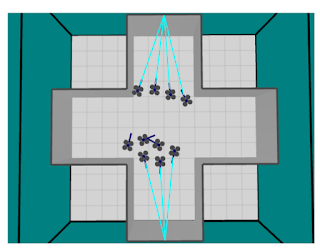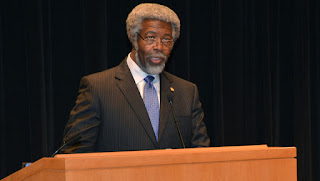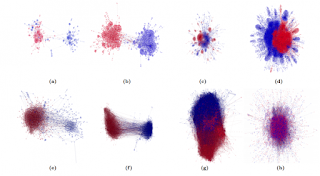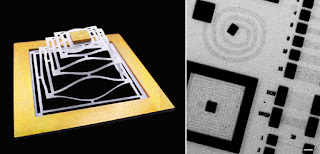All Posts (6505)
#TenThingsNotToSayToAWriter is a trending hashtag on the internet and one which Jodi Picoult, Amy Tan and others are having fun with...so I thought I'd chime in. After three decades of living the writer's life, I have many more than ten juicy possibilities for this list. But here is my all-time personal favorite:
"I found your book at a garage sale! In the Free Box!"
 |
| Image Source: Technology Review |
Topics: Artificial Intelligence, Computer Science, Humor, Robotics, Science Fiction
I thought these articles were related, and I admit somewhat intriguing. The first regards Buzz, which is described in the paper's abstract as "a novel programming language for heterogeneous robot swarms," though I'm not sure if "swarm" is the operative word they should have had in their description. The second is a post on Technology Review titled: "Teaching Machines to Understand Us." [Ahem] We have a few that can - well, extrapolate to some extreme thought processes - I'm thinking of the recent shots fired in the Jade Helm 15 military exercises [1], and outrageous behavior encouraged by conspiracy provocateurs (that haven't participated). It doesn't help that some very good science fiction has speculated on this quite a bit, and a few of my fellow humans can't delineate between fantasy and reality. [2]
Abstract
We present Buzz, a novel programming language for heterogeneous robot swarms. Buzz advocates a compositional approach, offering primitives to define swarm behaviors both from the perspective of the single robot and of the overall swarm. Single-robot primitives include robot-specific instructions and manipulation of neighborhood data. Swarm-based primitives allow for the dynamic management of robot teams, and for sharing information globally across the swarm. Self-organization stems from the completely decentralized mechanisms upon which the Buzz run-time platform is based. The language can be extended to add new primitives (thus supporting heterogeneous robot swarms), and its run-time platform is designed to be laid on top of other frameworks, such as Robot Operating System. We showcase the capabilities of Buzz by providing code examples, and analyze scalability and robustness of the run-time platform through realistic simulated experiments with representative swarm algorithms. [3]
The first time Yann LeCun revolutionized artificial intelligence, it was a false dawn. It was 1995, and for almost a decade, the young Frenchman had been dedicated to what many computer scientists considered a bad idea: that crudely mimicking certain features of the brain was the best way to bring about intelligent machines. But LeCun had shown that this approach could produce something strikingly smart—and useful. Working at Bell Labs, he made software that roughly simulated neurons and learned to read handwritten text by looking at many different examples. Bell Labs’ corporate parent, AT&T, used it to sell the first machines capable of reading the handwriting on checks and written forms. To LeCun and a few fellow believers in artificial neural networks, it seemed to mark the beginning of an era in which machines could learn many other skills previously limited to humans. It wasn’t. [4]
1. Jade Helm: The Insanity that Ate Texas, Jim Wright, Stonekettle Station
2. Why Operation Jade Helm 15 is freaking out the Internet — and why it shouldn’t be, Dan Lamothe, Washington Post
3. Physics arXiv:
Buzz: An Extensible Programming Language for Self-Organizing Heterogeneous Robot Swarms, Carlo Pinciroli, Adam Lee-Brown, Giovanni Beltrame
4. Teaching Machines to Understand Us, Tom Simonite
Diverse Heroes are Here Ready to Read
Topics: Computer Science, History, Humor, Internet, Politics, Social Media
Poignantly, today is the 70th anniversary of the atomic bomb dropped on Hiroshima; as a species we entered the era where mass extinction became a troubling, crystallized thought. The BBC has a short presentation on their web site commemorating this history.
Equally significant and jarring: The first presidential debates are tonight from a party on the 50th anniversary of the Voting Rights Act, that has made disenfranchising minorities from the voting booths for a non-existent problem a political tactic. That, thanks to 5 justices on the Supreme Court (ONE which I can arguably say left the African American community despite his physical attributes decades ago), gutting the provision that covered nine states, eight of which in the old Confederacy. A conservative circuit court with clearer legal vision saw through the canard in Texas and put full stop to that dark procedure in the Lone Star State.
I will fortunately be at work during this "debate." I can only stomach so much bombast and hyperbolic over-the-top rhetoric. I'll likely look at the analysis, soundbites and yes: Tweets.
Sadly, like most of us, I'll be looking for the "fireworks."
TECHNOLOGY REVIEW: Many a controversy has raged on social media platforms such as Twitter. Some last for weeks or months, others blow themselves in an afternoon. And yet most go unnoticed by most people. That would change if there was a reliable way of spotting controversies in the Twitterstream in real time.
That could happen thanks to the work of Kiran Garimella and pals at Aalto University in Finland. These guys have found a way to spot the characteristics of a controversy in a collection of tweets and distinguish this from a noncontroversial conversation.
Various researchers have studied controversies on Twitter but these have all focused on preidentified arguments, whereas Garimella and co want to spot them in the first place. Their key idea is that the structure of conversations that involve controversy are different from those that are benign.
Physics arXiv: Quantifying Controversy in Social Media
Kiran Garimella, Gianmarco De Francisci Morales, Aristides Gionis, Michael Mathioudakis
 |
| Image source: National Physical Laboratory |
Topics: Carbon Nanotubes, Diversity, Diversity in Science, Engineering Physics, Materials Science, Nanotechnology, Semiconductor Technology, Women in Science
Stephanie Moroz and I share the same background in Engineering Physics and both in the same industry at the moment (she has extensive experience in other areas as well, and I'm not a CEO). She gives an excellent primer presentation at TEDx:
What is nanotechnology? Stephanie Moroz explores some of the ways that designing materials at an incredibly small scale can address global challenges in fields such as energy, medicine and electronics.
Stephanie Moroz is the CEO of Nano-Nouvelle, a Sunshine Coast company developing high-performance battery electrodes. Her international career has been dedicated to commercializing new technologies, particularly in the areas of energy efficiency and nanomaterials.
Stephanie is a truly global citizen. With her education in engineering physics, she has worked in Canada and then Germany where she led the integration of hydrogen fuel cells into the Mercedes F-CELL vehicle. From there she moved to France, developing systems to reduce the pollution generated by conventional vehicles. Finally, she was lured to Australia by opportunities in nanotechnology: first in solid-state hydrogen storage and now innovative battery materials at Nano-Nouvelle.
This talk was given at a TEDx event using the TED conference format but independently organized by a local community. Learn more at http://ted.com/tedx
This is the final 6 days of the Kickstarter campaign for the creator-owned original title BLEED 2039 thru my studio (AHR VISIONS) and I would REALLY appreciate your support in getting it fully funded! It is over 65% near goal and I am confident it can make it to the finish with the right backers!
Here is the link: https://www.kickstarter.com/projects/291655160/bleed-2039
Thank you all in advance for any support you care to offer and please share!
~ AHR
Topics: Black Holes, CERN, God Particle, Heisenberg Uncertainty Principle, Humor, Large Hadron Collider, Particle Physics
Realize that the site Addicting Info usually titles its post with bombastic themes for equally outrageous stories. My response to this one regarding the latest conspiracy provocateur to enjoin that the Large Hadron Collider will "open other dimensions" or in a new twist, it's the "new Tower of Babel," and that its operation is a "dark and terrible chapter in human history." I posted the above meme sentiment and the following statement:
The "dark and terrible" chapter in human history is the willful choice of scientific ignorance in the 21st Century.
That got a lot of responses on Facebook, hundreds mostly positive with the exception of two trolls: one that ranted and the other that chimed in. They had their say and were brief and silent after that for the most part. The only dark and terrible time I can think of is the dark ages.
Willful meaning that with our access to the Internet and before that a public library, this kind of bombast without qualification is rather inexcusable. The only motivation is to pull a certain section of society towards your worldview; the only strength of your position is their ignorance, which unlike Thomas Gray's Ode on a Distant Prospect at Eton College, is not "bliss" or necessity: it is control.
A brief history of accelerators and particle physics:
Accelerators: John D. Cockcroft and Ernest Walton at the Cavendish Laboratory in Cambridge, England, sought a way into the nucleus through a prediction of quantum mechanics. George Gamow had suggested that a particle with too little energy to overcome the electrical repulsion of the nucleus through the barrier. (The trick was that the energy of the particle was not actually well-defined, according to Heisenberg's Uncertainty Principle). In 1930 Cockcroft and Walton used a 200-kilovolt transformer to accelerate protons down a straight discharge tube, but they concluded that Gamow's tunnelling did not work and decided to seek higher energies. [1] The Bubble Accelerator was designed by Donald A. Glaser, a popular apocryphal story about him contemplating the design over beer: it's something you hear as an undergrad and never, ever forget! He did win the Nobel Prize in 1960 for the Bubble Chamber.
Some examples:
Van der Graaf generator: If your high school physics teacher had you touch it and your hair stood on end like an Afro, THAT was a particle accelerator, no dimensions were opened or damaged in these experiments.
X-rays and nMRI: Nuclear Magnetic Resonance Imaging comes to mind. If you've had these procedures in a medical event, you have particle physics to thank for it.
Related info:
Black Holes: The byproduct of Red Giant stars that collapse after their nuclear fuel is spent at the end of their lifetimes. Our own sun at its end will likely become a Brown or White Dwarf, as it's not that massive. A large part of the analysis to even propose Black Holes was developed during the Second World War in the development of the atomic bomb. It was once so extreme, not even Einstein believed they could exist, though General Relativity pretty much predicted it. [2, 3]
CERN: European Organization for Nuclear Research. Here's a link that is a PDF on technological spin offs, some of which are things like, I don't know: the World Wide Web. The rants I've seen on web sites (or, even responses to some of my posts in the past) are breathtaking in their hypocrisy. I'd have more respect for a group that sincerely went back to snail mail, the Abacus and Slide Rule (I have the latter). There's even spin offs for treating cancer and solar panels.
The God Particle: Also known as the Higgs Boson. It was coined by Nobel Prize winning physicist Leon M. Lederman and science writer Dick Teresi in a book by the same name, the subtitle an obvious nod to "Hitchhiker's Guide to the Galaxy": The God Particle: If the Universe is the Answer, What Is the Question? Lederman often joked due to the frustration at the time not having found it - with a colorful metaphor what else he would like to have called it. In this case, 42 didn't quite cover it.
Particle Physics: "Particle physics is the branch of physics that studies the nature of the particles that constitute matter (particles with mass) and radiation (massless particles). Although the word "particle" can refer to various types of very small objects (e.g. protons, gas particles, or even household dust), "particle physics" usually investigates the irreducibly smallest detectable particles and the irreducibly fundamental force fields necessary to explain them. By our current understanding, these elementary particles are excitations of the quantum fields that also govern their interactions. The currently dominant theory explaining these fundamental particles and fields, along with their dynamics, is called the Standard Model. Thus, modern particle physics generally investigates the Standard Model and its various possible extensions, e.g to the newest "known" particle, the Higgs boson, or even to the oldest known force field, gravity." Wikipedia
Wormholes: See Kip Thorne's book below [2]. It was the Einstein-Rosen Bridge seen in the movies Contact from Carl Sagan's novel and most recently, Marvel's Thor. An advanced civilization that lived beyond its technological adolescence (i.e., they didn't blow themselves to kingdom come) could probably engineer one.
So, rather than a soundbite, I thought it important to give longer explanations. It's easier to find out How Accelerators Work [4] by simply going to a site where experts give an explanation for consumption by the general public.
As a country, we have a historic fear and loathing of science - the aforementioned bomb [3] and the Tuskegee Experiments didn't help. This "dark and terrible chapter" for the most part had a lot of positive spin offs that have benefited everyone. Now, ignorance is a choice, but not a permanent state of affairs. As Carl Sagan said, "We live in a society exquisitely dependent on science and technology, in which hardly anyone knows anything about science and technology." That state can be remedied.
1. American Institute of Physics: Early Particle Accelerators
2. "Black Holes and Time Warps-Einstein's Outrageous Legacy," Kip Thorne
3. #P4TC: M.A.D...
4. CERN: How Accelerators Work
 |
| covers by Ida at Amygdala Design |
I really find creating maps for books a fun change of pace. These two maps are for David H Millar's CONALL book series, being published through A Wee Publishing Company.
Topics: Bose-Einstein Condensate, Condensed Matter Physics, Lasers, Quantum Mechanics, Thermodynamics
A reservoir of ultracold atoms that is topped-up continuously has been unveiled by physicists in Germany and Denmark. The system can store 38 million rubidium atoms at a temperature of 102 μK, and the team says that it could be adapted to work for a wide range of particles and trapping methods. Applications of the reservoir include using the cold atoms in metrology systems or to cool other gases or even tiny objects.
Gases of ultracold atoms and molecules are used in a wide range of applications, including atomic clocks and simulating quantum effects in solid materials. While physicists have come a long way in developing and perfecting techniques for cooling gases to temperatures as low as 50 pK, these are "one-shot" systems in which the gas is cooled in isolation and then the atoms are put to use until their numbers are exhausted or the gas is destroyed by making a measurement. In some cases, however, it would be useful to maintain a continuous reservoir of ultracold atoms that could be used to perform continuous metrology or to cool other systems.
Now, Jan Mahnke and colleagues at Leibniz Universität Hannover and Aarhus Universitet have created a continuously pumped reservoir of ultracold atoms that is integrated within an L-shaped device that is made from a copper block measuring several centimetres across (see image above). The cooling process begins in a separate device that functions as a 2D magneto-optical trap (MOT). This uses laser beams and magnetic fields to cool and guide about 10 billion rubidium-87 atoms at temperatures as low as 25 μK. Some of these atoms are then transferred to the first stage of the reservoir device, which is a 3D MOT that can store about 2 billion atoms.
Physics World: Reservoir of ultracold atoms is filled continuously, Hamish Johnston
Did you know that if only 10% of the members of BSFS participated in this deal that we could create a black owned and operated network that would be dedicated to giving black sci fi writers a platform to promote their work AND create a Black SciFi event that could travel to at least 3 major cities??? We are trying to get as many people as possible to make this one time advertising deal! You could be physically in front of at least 20,000+ people weekly and many more streaming LIVE 24/7 on our digital platform!!!
Are you ready to be a part of the solution?
 |
| Image Source: IMDb |
Topics: Democracy, Exceptionalism, Internet, Oligarchy, Republic
We are now days from the first debates of the presidential cycle - The Cycle, NOW with Alex Wagner and the Ed Show cancelled on MSNBC due to executives kowtowing at the arcane Nielsen altar, which worked well when you had only ABC, CBS NBC and a few UHF channels: on-demand television and cable viewing, Net Flicks, Amazon Prime et al and pretty much NO ONE in America working a standard 9 - 5 whereby they can park and watch Walter Cronkite at 6:30 pm has somewhat changed the game for the non-Fox audience that's not older, whiter, more conservative and semi or fully retired. We've been in the throws of reality television since Candid Camera in 1948. It has been the recent advent of Internet technology; instantaneous gratification by pointing and clicking that allows us all to "vote" for our favorite dancer/singer from the comfort of our living rooms that have allowed us all to participate in what used to be merely voyeurism with the boob tube. I currently have several apps on my smart phone, one of them allowing me to order a sandwich - days in advance - and pick it up at the shop at an appointed time and on a "rapid pick up" shelf.
"The Donald": a self-made billionaire with cheap toupee or poor comb over inherited his fortunes from his self-made millionaire father, and continued in the family business. He's had a triplet series of traditional marriages and far more bankruptcies. Someone at a New Hampshire focus group said: "he's just like us" while another woman said "he was classy." Unless you are worth billions and have a string of marriages and business bankruptcies, he's not "just like us"; and madam: if a bloviating bigot is your definition of "classy," I fear you need to get out more.
 |
| Image source: Super Mario Wiki and this blog |
The Donald is a reality TV star - part of a long list of reality shows I don't watch - host of The Apprentice - and publisher of several books on his business philosophy and self-importance. He's been around notoriety-wise since the 1980's when he was much thinner and had exceptionally more hair. And now, his time has come. We have been conditioned like Pavlov's dogs from the sixty-seven year onslaught of filler television programming to consider his bid for the presidency genuine. We had a B-movie actor - why not The Donald? Conventional wisdom is he would have imploded by now and slinked back to his show with a boost in draconian Nielsen ratings. He's not doing it now. The oligarchs are likely quite confused, amused and nervous. As the departing Jon Stewart remarked [paraphrased]: "as a 1%er, he's supposed to BUY politicians, not actually become one." For the likes of the Koch brothers, the sock puppets Scott Walker and Chris Christie are "their kind of guys." The Donald is a loose and unpredictable cannon, following the formula that gets your reality primary high ratings. By going with the top 10 averaged in national polls, it encourages bombast and outrageous behaviors such that it is essentially what the GOP primary has become.
From above: "I currently have several apps on my smart phone, one of them allowing me to order a sandwich - days in advance - and pick it up at the shop at an appointed time and on a 'rapid pick up' shelf." Question: if we can do this with apps to get food and vote for our favorite contestant on "reality TV," why are we NOT doing it for the voting franchise? With mobile technology, ~90% of 311 million people voting would be a far louder voice than "corporations are people" Citizens United decisions that ushered in this current non-democratic (or, republic for that matter) model. Former President Carter disabused us of any illusions if we weren't already.
Answer: it would be "too much democracy." Now, that sounds horrifying on its face, but as a nation, we're somewhat prone not to reason, examination of facts/details/data and debate, but someone who sounds confident; "the decider" who "goes with his gut"; rides tall in the saddle even though he had as many deferments as Dick Cheney during the Vietnam conflict. The aforementioned, underlined link in the first sentence is one of many I found just searching on the term itself. Carnival barkers of Trump's mold - like used car salesmen - don't have to BE genuine, but like reality TV, they MUST at least sound genuine. We are ripe for an authoritarian, carnival barker or otherwise.
George Carlin - public intellectual, ever timely and prescient of the current election cycle with his stand-up: "Dumb Americans." American Exceptionalism is the mythology we tell ourselves, and provocateurs like Trump - strides in and yells it loud to adoring crowds. He has no solutions; no specifics. His hand gestures have become caricature, yet his appeal is due to the systematic dumbing down we've experienced for a little over two generations now. Science and technology - paramount to our survival - will exist in a parallel reality, its warnings ignored, as obedient Pavlov hounds bay at the previous month's blue moon and the rich wolves count the dividends they will send overseas, away from these shores, its crumbling roads, schools and infrastructure.
To quote Lawrence Lessig, we are a Republic, Lost.
An enlightened citizenry is indispensable for the proper functioning of a republic. Self-government is not possible unless the citizens are educated sufficiently to enable them to exercise oversight. It is therefore imperative that the nation see to it that a suitable education be provided for all its citizens. It should be noted, that when Jefferson speaks of "science," he is often referring to knowledge or learning in general.
"Testing Theories of American Politics: Elites, Interest Groups, and Average Citizens," Martin Gilens and Benjamin I. Page
The US military is developing a new non-lethal weapon that uses an incredibly loud sound to startle an enemy into retreating.
The Laser-Induced Plasma Effect (LIPE) weapon was designed by the Joint Non-Lethal Weapons Program (JNLWP), which is part of the US Department of Defense. It works by making use of plasma, a type of matter that isn't a liquid, solid or gas.
In the plasma stage, high doses of energy have pulled electrons from their atomic nuclei, creating ions, and this produces a type of matter that has both electrical and magnetic properties and can take on the form of light.
The idea is for the LIPE weapon's lasers to fire directed high energy in extremely short bursts that last for only a nanosecond (a billionth of a second). The energy creates a blue ball of plasma and further blasts of energy from the lasers manipulate the ball to make a super loud, 130-decibel sound that sounds like a fighter jet has come out of nowhere next to the target.
Topics: Consumer Electronics, Electrical Engineering, Nanotechnology, Semiconductor Technology
A stretchable and bendable transistor has been made by researchers in the US by applying the principles of kirigami – the Japanese art of paper cutting – to graphene. The researchers have also made tiny graphene-based hinges and pyramids, and they are confident that they could reduce the size of their devices to the nanometre scale. The team also points out that the current micro-scale devices could be useful for biocompatible electronics, including probes for the study of neurons.
The mainstay of the electronics industry, silicon, is rigid and brittle, and is therefore not appropriate for making deformable electronics. The ability to deform is particularly useful for electronic devices that interface with biological organisms, for example sensitive prosthetic skin and subcutaneous sensors, which must bend and stretch with surrounding tissue. Graphene is a flexible sheet of carbon just one atom thick, and could offer a way to create deformable electronics because of its high electrical conductivity. One problem with graphene, however, is that it stretches very little.
Nanoscientist Paul McEuen and colleagues at Cornell University in Ithaca, New York, were inspired to try graphene kirigami after they investigated the bending stiffness of the material. They used an infrared laser beam to press on a gold pad located on the tip of a graphene cantilever that is about 10 μm long. By measuring the displacement in response to the known force of the laser photons, they calculated the bending stiffness of the material. They also monitored the thermal oscillations of a graphene cantilever and calculated the stiffness from the oscillation amplitude.
Physics World: Stretchable graphene transistors inspired by kirigami, Tim Wogan
 |
| Image Source: American Association for the Advancement of Science (link below) |
Topics: Diversity, Diversity in Science, Economy, Education, Science, STEM, Research
It's easy to bash millennials until you're in two classrooms with them. I taught Algebra, Pre Calculus and Physics between two campuses in Texas: Hutto and Manor High Schools respectively.
They're a lively bunch; probably better than an Expresso if you "really" want to wake up (or, even if you don't).
It's nice when someone of Dr. Gate's stature recognizes and encourages it as well.
I have a selfish interest encouraging this observed collaborative spirit as well: I'd like to retire with the store "fully functional" on my departure from the workforce (one day).
I thoroughly enjoyed my "coming of age" in the 1980s, but I do envy millennials - this is your time: a time of both great perils to be solved and great wonders to be discovered. It depends on what you're willing to step forward and emphasize that will shape the future, quite literally for the entire planet and species.
The U.S. R&D enterprise needs more support, but millennials, born near the end of the 20th century, share characteristics that will serve them well if they become scientists, S. James Gates Jr. said at the AAAS-Hitachi lecture.
The United States used science and technology to great economic benefit after World War II and can continue to "master the innovation cycle" by drawing on the collaborative nature of millennials who started to come of age as the century turned, a leading physicist told a AAAS gathering recently.
S. James Gates Jr., a theoretical physicist at the University of Maryland and self-described policy wonk, shared his thoughts on the future of "big science" and the challenges the nation faces as it responds to increased scientific and economic competition from abroad.
He noted that millennials, those born between 1982 and 2000, now make up a larger percentage of the U.S. population than the baby boomers born after World War II. According to the Census Bureau, millennials number 83.1 million and account for more than one quarter of the U.S. population while the boomers number 75.4 million. The millennial generation also is more diverse, Gates said, offering the possibility that creative new approaches to science may emerge.
 |
| From Forbes: "Why You Can't Ignore Millennials," Dan Schawbel |
The millennials show a willingness to embrace dramatic social shifts, are comfortable with the new technologies that have connected us via the Internet, and exhibit "a far more collaborative" streak than some previous generations, Gates said. That willingness to work in groups, share information and ideas, and collaborate on projects is highly compatible with the methods and goals of science, and Gates said it is something to be admired and fostered.
AAAS: Collaborative Spirit of Millennial Generation May Benefit Big Science, Earl Lane
This is the first part of our effort to build a base of Black Businesses who are willing to work with a Black Owned and Operated Media outlet dedicated to building the Black Community!!! Please tag and share it with anyone you know who has a book to promote!
So here is the deal we will offer to Authors in order to promote their books via our Black College Sports Network. Starting the weekend of Sept. 5th we will be broadcasting live from some of the top HBCU football games in the country. What do you do: Pay $100 and provide a standing banner to the network. What do you get: 100 60 second radio ads on the V108 radio network of your choice (Gospel, Urban or Talk) for one month (Sept-Nov), interviewed on one of the network talk shows and your banner posted at 3 games of your choice. Game choice is on a first come first serve basis. Game schedule will be released on Saturday August 22nd at our BCSN GameTime season kick off broadcast!
If your book is out or is coming out by November you can get in on Football season but we will be doing the same deal for Basketball season as well. Inbox me if you have more questions or you can make your payment PayPal to info@myjbn.com This deal is limited to 75 authors and the first 7 to sign up will get their 100 60 second radio ads and 25 video ads for all 3 months on our online tv station and all 3 radio stations!
If you guys read my previous blog on File Organization. You will clearly see how unorganized and scattered my files were. I had 133 Transportation graphics. I did the file and pile method where I will pile my files and look for it later. That is okay for an amateur who is doing personal projects for friends and family members. It is not an okay practice when working among professionals and corporate clients.
If you are in the creative field where you are a producer; writer; graphic, and motion designer; animator; video editor; website builder,etc. This blog is for you. I had 864 files of Illustrator Vectors that were scattered out in just one folder that were not identifiable. Out of 864 were the 133 Transportation graphics you seen in the previous blog. I finally got it organized where I can quickly identify and find what I am looking for. Putting these files in categories makes a big difference.
In this picture you can see the preview pane in the left showing the folders I created. Next to the preview pane you can see how I put the 133 Transportation graphics in categories. The folder I created was VEHICLE EXT. Under that category I created sub categories and folders. With vehicles you have to be specific according to their model and weight.
The problem was I was naming them common names such as Cars and Trucks. When file naming the vehicles Cars 1; Car 2; Car 95; Luxury Super Car; I was doing a keyword shortcut so I can search easily search it. When I was trying to find a specific car model. I went from Arkansas to Japan to find it. It took at 10 minutes or more to go find the right car model I wanted to use in a design.
It was frustrating going through a pile of files with the name Car at the end of it to find the right one. I realized it was time to put this vehicle models in categories and be as descriptive as possible. I created 11 folders with their sub categories within that folder. The key to better computer file organization for creative people is the method Category and Find.
The Category and Find method will help you to identify your files easily. You can find the folder associated with those files easily than to find scattered files with no categories. Take an extra three to four hours to organize your files using this method. You don't want to wait to get on team projects and not being able to deliver because of files disorganization.
In my next blog if you are working on multiple projects and you have more than 6,000 files. Be sure to check out my next blog called Projects and Non Projects.
 |
| Technology Review: A piece of pig skin glows with laser light after being stimulated by an optical fiber. |
Topics: Biomedicine, Humor, Laser, Modern Physics, Optical Physics, Photonics, Research
Yes, you read the post title right, and it's referenced in the title of the article at Technology Review. The technique has also apparently been done with human samples. I could only grin as I know a few of my Jewish and Muslim friends and family members who probably wouldn't think of such a device as "kosher."
Researchers have made pig-skin lasers. Yes, pig laser beams.
The technology, outlined in a paper published today in Nature Photonics, showed that pumping light into fat cells could turn them into tiny, self-contained lasers.
The microlaser technique could afford scientists new ways to study and use cells, but mostly it’s just “very cool,” says Russ Algar, an assistant professor at the University of British Columbia in Vancouver, Canada, who wasn’t involved in the work.
MIT Technology Review: Making Pig Fat into a Laser, Karen Weintraub
 |
| Image Source: Fig 2, CERN Courier article |
Topics: Black Holes, Cosmology, General Relativity, High Energy Physics, Particle Physics, Relativistic Quantum Mechanics, Theoretical Physics
Abstract
We demonstrate an algorithm for the retrieval of a qubit, encoded in spin angular momentum, that has been dropped into a no-firewall unitary black hole. Retrieval is achieved analogously to quantum teleportation by collecting Hawking radiation and performing measurements on the black hole. Importantly, these methods only require the ability to perform measurements from outside the event horizon and to collect the Hawking radiation emitted after the state of interest is dropped into the black hole.
Physics arXiv: How to Recover a Qubit That Has Fallen Into a Black Hole
Aidan Chatwin-Davies, Adam S. Jermyn, Sean M. Carroll













